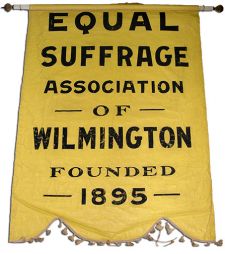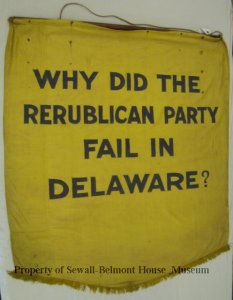
Equal Suffrage Association of Wilmington Banner. source: Delaware Historical Society. http://www.dehistory.org
After a more than 60 years of struggle to give women the right to vote, things were coming to a head during the second decade of the 20th century. The suffragists had won battles in a number of states, and were slowly converting indecisive politicians. But to keep the pressure on the holdouts, the more radical activists descended on Washington, D.C. for a massive march, picketing, and clever publicity stunts.
As the day neared for the big rally, March 3, 1913, Delaware was treated to a unique spectacle as a band of determined suffragettes tramped across the State, advancing on their objective, the occupation of Washington D.C. These feminists were determined to get the nation’s attention on the day before Woodrow Wilson’s inauguration. And to maximize publicity, the stalwarts had carefully mapped their route along paths George Washington traveled between New York and the Potomac.
On February 18, 1913, the suffrage army stepped sprightly into Delaware to the tune of “Marching through Georgia.” The first person to officially greet them was the Claymont postmaster, Eben H. Baldwin. A little ways down the road at the Robinson Mansion, Jeff Davis, a gentle bulldog adorned with “votes for women” strode confidently up to General Rosalie Jones.

Why did the Republican party fail in Delaware? This banner was used by the National Woman’s Party during picketing. A leg was added to the one R at some point. Source: Sewall Belmont House Collection. http://sewallbelmont.pastperfect-online.com/36836cgi/mweb.exe?request=record;id=B958B27F-B580-4572-8576-081674616648;type=101
At the Philadelphia Pike tollhouse William J. Whiteford, met the chief scout of the army, Olive Schultz. The scout car driver received an animal mascot, a kitten, donated by Mrs. Whiteford. Olive named it “Scouty” and said he would occupy a seat of honor when the brightly decorated vehicle rolled down Pennsylvania Avenue on March 3rd. Also at the tollhouse were Mrs. A. L. Steinlein, president of the Arden Suffrage Club and her supporters. For 10 years women had voted on village affairs.
Wilmington suffragettes met the pilgrims at Shellpot Park, to accompany them to city hall. Just beyond the park a fire engine rolled from the station house and whistled its salute, and all along the way sirens on fire engines and chiming bells echoed through the streets. “Seldom have Wilmingtonians turned out to welcome a set of propagandists as they did yesterday when the Pilgrims for Women Suffrage on their hike from New York to Washington arrived here,” the Evening Journal Reported.
Mayor Harrison W. Howell warmly greeted the Army of the Hudson at city hall. While welcoming the troops, he wanted it understood that he was not in entire sympathy with the cause as he said that few were in favor of extending the franchise. “May this city be the garden spot in your memories. While I cannot say I am heartily in favor of your views, I admire your pilgrimage,” he remarked
The weary hikers set up camp at the Hotel DuPont, while staying busy, seeking converts and spreading the word. At a noon meeting near the Pullman Car Company and that evening at the Harlan and Hollingsworth Corporation people heard campaign speeches. Also that evening they were guests at the Garrick Theatre, the manager W. L. Dockstader having invited the pilgrims to make an address. Alternating between five-minute suffrage speeches and the scheduled vaudeville acts, both types of performances were applauded, the News Journal reported.
Lausanne the suffrage mare pulling the ammunition wagon had been working hard on this tiring journey. So General Jones had a veterinarian check out her condition. The animal had been bought in Newark, NJ for $59.98 to pull Elizabeth Freeman’s literature wagon, and her fame was spreading. The vet said she was fine.
Having been well received in Wilmington over two days and following a final good night’s rest, they shouldered their knapsacks and escorted by Patrolmen Purcell, Barr, McGillin, and Chalender, started marching toward Newport. General Jones tried to persuade Mayor Howell to go with them, but he declined.
As they reached the top of the hill outside Newport, schoolboys from town greeted the hikers with supportive homemade signs. The bells on the church, school house and the fire station rang out as they marched into town with 30 pupils, where the Newport Equal Suffrage Club welcomed them.
With all of Newport turning out to welcome the activists, the women were joined in some roadside speechmaking by Martha S. Cranston and Elwood W. Johnson Commissioner of town schools. The inquisitive youngsters had plenty of questions when the general asked for them. “Why don’t you take the cars to Washington?” a small boy inquired. “The women must keep the cause before the public,” the General replied. “Are you a Democratic?” asked another. The speaker explained that like Susan B. Anthony she had not party until she had a vote. “Aren’t there enough men to vote?” another inquired. There were enough, but the important thing was that there were no women voting in some states,” was the reply according to the Baltimore Sun.
After that it was time to occupy Newark. The determined troops were on the outskirts of town when the Delaware College Cadet Corps sighted them. They had cut class in order to be able to escort the footsore commandos downtown. The college tried to continue with studies, but since so many scholars were missing they finally gave in, letting classes out in body. “Votes for Women” banners were seen all over Newark.
As the General led the troops, 175 uniformed cadets stood at attention in formation while their officers welcomed the hikers. They then fell in line and escorted the pilgrims to Deer Park. There the cadets withdrew to one side as the weary women, their spirits heightened by the greeting, went inside. The corps presented arms, then turned to march back to the college with the cadet’s band playing “the Girl I left Behind.”
General Jones was greeted by several local advocates and there was plenty of speechmaking in Newark. In response to a small boy’s question, “Do you want a women to become president the general laughingly replied, “I don’t expect to live to see it, but if the time should ever come I believe she would fill the position well,” a war correspondent reported.
Promptly at 4 o’clock the bugle sounded and the party fell into line for the tramp to Maryland, where they were to rest for the night.


